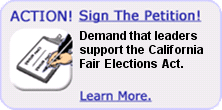
An Easy Way to Get More Political Bang for 3 Bucks
![]() Commentary
Commentary
The first question on your Form 1040 federal tax return is
whether you want $3 of your federal tax to go to the
Presidential Election Campaign Fund. "Checking 'Yes,' " you
are informed, "will not change your tax or reduce your
refund." Last year only 11% of tax filers checked off, down
from a high of 29% in 1978.
This is too bad. Over three decades, the fund has supplied
critical public matching funds to primary candidates and
subsidized the general election â€" in exchange
for limits on overall campaign spending. The program has
enabled voters to consider lesser-known or lesser-financed
candidates, from Jimmy Carter to John McCain. It has also
helped replace the unlimited contributions that were
allowed in past campaigns.
Yet today the system is in deep trouble. The presumptive
2004 Republican and Democratic nominees rejected public
financing in the primaries, complaining about
unrealistically low spending limits. The public financing
formula â€" which matches contributions
one-to-one up to the first $250 in individual contributions
â€" has failed to prevent candidates from
relying mainly on $1,000 to $2,000 donations.
A Campaign Finance Institute task force recommended higher
spending limits to keep candidates in the system and a
formula of three-to-one matching up to the first $100 in
contributions, to increase the importance of small donors.
But these reforms would require modestly increasing the
amount of the voluntary check-off and taking steps to stem
the decline in participation.
Opinion polls show that the reasons for this decline do not
include a growing public distaste for the presidential
financing system. Why then don't more taxpayers check it
off? One likely reason is that there has been virtually no
public education about the check-off.
Further, new electronic tax filing software discourages a
"Yes" response by taxpayers. Nearly 40% of Form 1040s were
filed electronically in 2003, four times the number in
1995. We know the most about the 11 million electronic
filings from home computers. Two products dominate this
market.
One, Intuit's Turbo Tax, displays the check-off question
with the proper notice about not increasing your taxes, but
the box is already checked "No." Unless you change it, it
will read "No" on your final tax return. The other program,
H&R Block's Tax Cut, asks if the taxpayer would like to
"contribute" to the campaign fund without saying that
checking the box would not increase your tax payment.
Leading programs used by professional tax preparers have
the same problems.
Congress should authorize the Federal Election Commission
to use some money from the existing fund for a real
education program (not propaganda) about its goals and
operations. And the IRS should mandate that authorized
electronic filing software not present a negative default
on the check-off question. It should offer a "Yes" and "No"
choice and clear notice that a "Yes" answer will not raise
your taxes.
Kenneth Blackwell, secretary of state of Ohio and a Republican, and Vic Fazio, former California congressman and chair of the House of Representatives' Democratic Caucus, are on the board of trustees
See the article on Los Angeles Times website
(In accordance with Title 17 U.S.C. Section 107, this material is distributed without profit to those who have expressed a prior interest in receiving the included information for research and educational purposes.)

